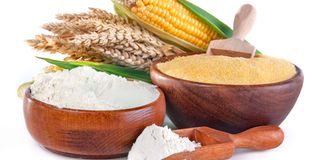Aflatoxin scare: MoH orders counties to destroy contaminated maize flour

The said brand of maize flour reported to have surpassed standard requirements of aflatoxin.
What you need to know:
- Brand of maize flour reported to have surpassed standard requirements of aflatoxin.
- Ministry of Health has also called for prompt action and regular updates on actions taken.
The Ministry of Health has issued a warning that a popular brand of maize flour is unfit for human consumption.
In a letter dated May 6, 2024, addressed to public county health officers in all 47 counties and copied to the Kenya Bureau of Standards, the Office of the Director General for Health said the maize flour contains a high level of aflatoxin.
Dr Patrick Amoth, the undersigned, noted that this brand has surpassed the standard requirements of aflatoxin, measured in parts per billion (ppb).
"Laboratory analysis on April 30 of Sherehe GSM maize flour with no batch number has shown that the flour contains a high level of aflatoxin above the requirements of 10.0 ppb. The level records 714ppb," the letter reads in part.
The Ministry has also ordered the immediate seizure of all existing stock of the maize meal flour in the Kenyan market and scaled up surveillance of all food products on the market.
Further, Nairobi County officers have been directed to carry out food inspection on the mill and "immediately stop the milling of the flour and distribution of the same."
The Ministry of Health has also called for prompt action and regular updates on actions taken.
According to Dr Charity Mutegi, a food scientist and food safety consultant, aflatoxin is a natural poison produced by mould. These moulds are fungi.
Dr Mutegi explains that there are different types of aflatoxin.
Causes acute death
"Aflatoxin is one of the mycotoxins, and it is so well-known because of its documented impact. Within the vast kingdom of aflatoxin, we have different kinds of aflatoxin," she says.
Aflatoxins have varying potency levels, such as aflatoxin B1, B2, G1, and G2. Aflatoxin B1 is the most potent and causes acute death.
"When you hear people talking about total aflatoxin, they're talking about a combination of B1, B2, G1 and G2. Aflatoxin is commonly in grains, beans, peanuts, and nuts like pistachios, but we don't grow them in this part of the world. They are also found in dry spices, especially chillies," she says.
Dr Mutegi also explains that aflatoxin is found in animal feed and other products such as milk.
"They have also been found in commodities like sorghum now, and when we talk about their presence in those crops, we are also talking about their products and byproducts."
Grains are a common culprit. Why?
"If you look at the surface area for colonisation and the ease at which maize gets infested by insects and other diseases, that can also predispose them to aflatoxin. Also, post-harvest management becomes a common point of contamination just because of the handling practices.
"Again, resistance to aflatoxin contamination goes beyond just the inherent properties of the plant itself. It also involves considering the physical characteristics of the kernel. One crucial factor is the pericarp, which is the hard outer shell of the kernel, often referred to as the 'tester' in maize breeding.
Aflatoxin levels
"Varieties with a thicker, harder pericarp (often described as having a 'hard tester') tend to offer better protection against fungal invasion compared to those with a thinner, softer pericarp ('soft tester')," Dr Mutegi explains.
The aflatoxin levels are measured in micrograms (µg) per kilogramme (kg) of the sample.
"Most countries, to protect their citizens, set the safe limit. Because it's very hard, especially in tropical areas, to get zero parts per billion. For instance, for Kenya, that has been set at 10 parts per billion for total aflatoxin. And five parts per billion for aflatoxin, B1. And these are the same standards that have been adopted within the EAC region. This is why, besides keeping the citizens safe, we also look to harmonize standards across the region," says the researcher.
"But that is not to say that it is a global threshold. A country will set its threshold based on the risk. For the European Union (EU), it's four parts per billion for total aflatoxin and two parts per billion for aflatoxin B1. The United States of America has 20 parts per billion, which is even higher than Kenya," she says.
In this context, where the threshold is above 714 ppb, Dr Mutegi says it shouldn't be fed even to animals.
The only solution for a level like that is, you either decontaminate it or just dispose of it."
What levels are considered fatal?
"Scientifically speaking, you cannot put a specific value because there are many factors that determine how an individual will respond, from their general immune system, medical conditions, sex, and age," she explains.





